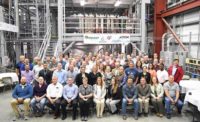
The U.S. Dept. of Energy's most intricate groundwater circulator will go on line in late June at the Hanford nuclear waste site in eastern Washington. It will begin treating, over the next 25 years, 25 billion gallons of water with high levels of radioactive and chemical contaminants.
The Hanford treatment plant is the largest such facility in DOE's nationwide complex of former nuclear production plants and the first of any of facilities to win LEED Gold certification for sustainability in construction and operation.
The $95-million, 52,000-sq-ft treatment facility combines extraction and injection points with a multifaceted water-filtering process to cycle 2,500 gallons of water per minute through a system designed to remove radioactive particulates, such as uranium, and other contaminants, such as chromium, trichloroethelyne and nitrates, says John Morse, DOE's on-site senior technical adviser.
The plant is in an area of the 560-sq-mile Hanford site that was core to decades of nuclear-weapons production. Radioactive and chemical wastes stored underground already have leaked into groundwater.
The contaminated plume has spread through a 5-sq-mile area and now threatens the Columbia River, Morse says.
CH2M Hill Plateau Remediation Co., which manages cleanup activities in that part of the site, worked on the plant under a stimulus-funded design-build contract. Able to expand to 3,750 gallons per minute, the treatment plant is 10 times larger than any other built at Hanford. It will replace one that now pumps 400 gpm.
Kent Dorr, CH2M Hill vice president for engineering, projects and construction, says the firm first had to design a grid system to place 19 extraction wells and 15 injection wells that can "squeegee dirty water toward extraction."
The wells push out tainted water to the treatment facility before pumping it back into the plume. "The clean water keeps pressing contaminated water to the extraction wells," Dorr says. "We will start realizing improvement in groundwater when we start extracting clean water."
Once removed from the ground, any water with traces of radioactivity is pumped directly from extraction to the radioactive treatment area, where resin vessels remove the contamination before the water pumps back into the stream toward biological filtration.
There, fluidized-bed reactors remove nitrates. Iodine, carbon solvents and other contaminants are then removed using standard microbiology processes.
Before the water is reinjected into the plume, it undergoes a final air-stripping process. "Putting this all together is a unique application," Morse says. The resulting waste is sludge that is suitable for shipment to a landfill.
Despite the project's speed—CH2M Hill broke ground in June 2010—the firm and its subcontractors realized their recycling goals, including about 50% of all steel used, 420 tons of recycled concrete and 75% of building waste.
The use of efficient design will save more than 70% in energy costs over the building's life, Dorr says. DOE officials believe the lessons learned in combining multiple functions into a large-scale project can translate at other agency sites.




